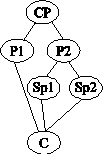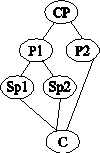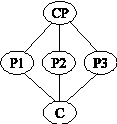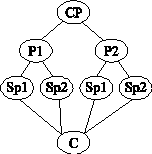1 . Most people have been taught that losing weight is a matter of simple math. Cut calories—specifically 3,500 calories, and you’ll lose a pound. But as it turns out, experts are learning that this decades-old strategy is actually pretty misguided. “This idea of ‘a calorie in and a calorie out’ when it comes to weight loss is not only outdated, it’s just wrong,” says Dr. Fatima Cody Stanford, an obesity specialist at Harvard Medical School. The truth is that even careful calorie calculations don’t always yield(产生) uniform results.
How your body burns calories depends on a number of factors. Three factors affect how your body processes calories.
Your gut microbiome (肠道微生物). Trillions of organisms live in your gut, and the important types may influence how many calories your body absorbs from food. This may occur because some types of organisms are able to break down and use more calories from certain foods than other types of organisms. Researchers have found that people who are naturally thin have different types of organisms living inside them than those who are overweight.
Your metabolism (新陈代谢). Each body has a “set point” that governs weight, says Dr. Stanford. This set point reflects several factors, including your genes, your environment, and your behaviors. A region at the base of your brain stands guard to keep your body weight from dipping below that set point—which is not really a bonus if you’re trying to lose weight.
The type of food you eat. Your food choices may also influence your calorie intake, and not just because of their specific calorie content. One 2019 study published in Cell Metabolism found that eating processed foods seems to spur people to eat more calories compared with eating unprocessed foods.
If counting calories isn’t a dependable way to manage your weight, what can you do to shed extra pounds? Dr.
Stanford recommends the following.
Focus on diet quality. When planning your meals, focus on choosing unprocessed foods, including lean meats, whole grains, and lots of fruits and vegetables in their natural form.
Exercise regularly. Aim to get at least 150 minutes of moderate-intensity exercise each week. Moderate exercise is done at a level where you can talk, but not sing.
Consult a professional. “A lot of people believe it’s a moral failing if they are unable to lose weight,” says Dr. Stanford. But it’s not. As with other medical conditions, many people will need help from a doctor. Successful weight loss may require more than just diet and exercise. “Only 2% of people who meet the criteria for the use of anti-obesity medications actually get them. This means that 98% of people who could be treated aren’t,” she says, “Don’t be afraid to seek help if you need it.”
1. What can we infer from Paragraph 1?| A.Old theories actually mislead us. |
| B.Losing weight lies in losing calorie. |
| C.Calorie calculations lead to good results. |
| D.Losing weight by losing calorie is outdated. |
| A.choose the types of food you consume |
| B.focus on the quality of your diet |
| C.adjust your brain to the “set point” |
| D.reduce the organisms living in your gut |
| A.weigh | B.produce |
| C.lose | D.cost |
| A.cutting calories is essential for weight loss |
| B.losing weight can be double-edged |
| C.healthy eating keeps you losing weight |
| D.a healthy lifestyle is key to weight loss |
2 . Social Networking Sites: Are They Changing Human Communication?
It is hardly news that people are using the Internet to communicate with others more and more. Some people fear that someday we will no longer feel the need to talk to one another face to face. However, some recent studies suggest that people communicate, or stay in touch, even more than they used to. Whichever side you fall on, what is clear and without a doubt is that human communication has changed in the 21st century. But results of recent scientific studies may have us reconsider just how much our new communication forms have changed our world.
In June 2008, a British psychiatrist, Himanshu Tyagi, warned that communicating on social networking sites could have a negative effect on the generation of people born after 1990. This generation has never known a world without the Internet. Tyagi says that these people use the Internet to communicate with others so much that they may have trouble forming real relationships. Tyagi is concerned that people may start and end relationships over the Internet. Describing the Internet he said, “It’s a world where everything moves fast and changes all the time, where relationships are quickly ended at the click of a mouse.”
Another psychologist, Dr. Aric Sigman, warned of the physical effects that come with using social networking sites. He suggests that the reduction in the amount of time we spend interacting (互动交流) with people face to face could have biological effects on the human body. The results of his study suggest that, without real personal interaction, the body does not react the same way it would if people were meeting face to face. As a result, immune responses, even hormone levels, can be changed. These changes may lead to the development of illnesses, such as cancer.
Despite these warnings, studies can be found that show the positive sides of social networking sites. The results of one study show that using social networking sites has increased the self-esteem (自尊心) of young adults. Another suggests that college students using these sites feel more “connected” with people when they use them. In addition to scientific studies, there are many who feel that the benefits of social networking sites outweigh the possible negative sides. Many people, especially those who spend a lot of time at home, for various reasons, find the Internet a lifeline. They are able to communicate with many people using these sites.
Perhaps the key to this new communication style is self-control and common sense. If someone spends all of his time on the Internet, and never actually sees friends face to face, that seems like an unhealthy way to live. But if someone spends time on the Internet, some of which is spent arranging meetings for “real” time together, then it seems almost complementary (互补的). Balance is the key to keeping communication alive and well in the 21st century.
1. Which of the following ideas may Himanshu Tyagi agree with?| A.Social networking sites harm people of all ages. |
| B.The Internet weakens young people’s relationships. |
| C.The use of the Internet improves people’s immune system. |
| D.The online world pushes people to live a faster and better life. |
| A.It will stop the face-to-face interaction. |
| B.It reduces the self-esteem of young adults. |
| C.It may cause some serious health problems. |
| D.It makes people feel less connected with others. |
| A.Are greater than. | B.Are heavier than. |
| C.Are more effective than. | D.Are more difficult than. |
CP: Central Point P: Point Sp: Sub-point(次要点) C: Conclusion
A. | B. |
C. | D. |
3 . Round and Round They Go
Space is becoming more crowded. Quite a few low-Earth-orbit (LEO) satellites have been launched into the sky, which are designed to move around the Earth only a few hundred kilometres above its surface. SpaceX and OneWeb plan to launch LEO satellites in their thousands, not hundreds, to double the total number of satellites in orbit (轨道) by 2027.
That promises to change things on Earth. LEO satellites can bring Internet connectivity to places where it is still unavailable. This will also be a source of new demand for the space economy. Morgan Stanley, a bank, projects that the space industry will grow from $350 billion in 2016 to more than $1.1 trillion by 2040. New Internet satellites will account for half this increase.
For that to happen, however, three worries must be overcome. Debris (碎片) is the most familiar concern. When enough satellites were packed into low-Earth orbits, any collision (碰撞) could cause a chain reaction which would eventually destroy all spaceships. One solution is to grab the satellites with problems and pull them down into the Earth’s atmosphere. Another is to monitor space more closely for debris. But technology is only part of the answer. Rules are needed to deal with old satellites safely from low-Earth orbits.
Cyber (网络的)-security is a second, long-standing worry. Hackers (黑客) could take control of a satellite and steal intellectual property, redirect data flows or cause a collision. The satellite industry has been slow to respond to such concerns. But as more of the world’s population comes to rely on the space for access to the Internet, the need for action will intensify. Measures will surely be taken to protect network security.
The third issue follows from the first two. If there is a simple mistake or a cyber-attack, it may cause a chain reaction which wipes out hundreds of billions of dollars of investment. Who is responsible for that? Now the plans of firms wishing to operate large numbers of satellites are being studied. But there is a long way to go before the risks are well understood, let alone priced.
As space becomes more commercialized, mind-bending prospects open up: packages moved across the planet in minutes by rocket rather than by plane, equipment sent to other small planets, passengers launched into orbit and beyond. All that and more may come, one day. But such activities would raise the same questions as LEO satellites do. They must be answered before the space economy can truly develop.
1. What can we learn about LEO satellites from the passage?| A.They are supposed to limit the space economy. |
| B.They are expected to increase in large numbers. |
| C.They are designed to move beyond the Earth as far as possible. |
| D.They are mainly intended to bring Internet connectivity to remote areas. |
| A.depending entirely on the modern technology |
| B.monitoring the movement of spaceships carefully |
| C.strengthening rules to remove old satellites safely |
| D.destroying all the satellites with problems instantly |
| A.Measure. | B.Increase. | C.Spread. | D.Repeat. |
| A.It should be further confirmed for its ownership. |
| B.It should be continued because of its advantages. |
| C.It should be done carefully to avoid potential risks. |
| D.It should be stopped in face of the space economy. |
4 . Certain forms of AI are indeed becoming ubiquitous. For example, algorithms (算法) carry out huge volumes of trading on our financial markets, self-driving cars are appearing on city streets, and our smartphones are translating from one language into another. These systems are sometimes faster and more perceptive than we humans are. But so far that is only true for the specific tasks for which the systems have been designed. That is something that some AI developers are now eager to change.
Some of today’s AI pioneers want to move on from today’s world of “weak” or “narrow” AI, to create “strong” or “full” AI, or what is often called artificial general intelligence (AGI). In some respects, today’s powerful computing machines already make our brains look weak. AGI could, its advocates say, work for us around the clock, and drawing on all available data, could suggest solutions to many problems. DM, a company focused on the development of AGI, has an ambition to “solve intelligence”. “If we’re successful,” their mission statement reads, “we believe this will be one of the most important and widely beneficial scientific advances ever made.”
Since the early days of AI, imagination has outpaced what is possible or even probable. In 1965, an imaginative mathematician called Irving Good predicted the eventual creation of an “ultra-intelligent machine…that can far surpass all the intellectual (智力的) activities of any man, however clever.” Good went on to suggest that “the first ultra-intelligent machine” could be “the last invention that man need ever make.”
Fears about the appearance of bad, powerful, man-made intelligent machines have been reinforced (强化) by many works of fiction — Mary Shelley’s Frankenstein and the Terminator film series, for example. But if AI does eventually prove to be our downfall, it is unlikely to be at the hands of human-shaped forms like these, with recognisably human motivations such as aggression (敌对行为). Instead, I agree with Oxford University philosopher Nick Bostrom, who believes that the heaviest risks from AGI do not come from a decision to turn against mankind but rather from a dogged pursuit of set objectives at the expense of everything else.
The promise and danger of true AGI are great. But all of today’s excited discussion about these possibilities presupposes the fact that we will be able to build these systems. And, having spoken to many of the world’s foremost AI researchers, I believe there is good reason to doubt that we will see AGI any time soon, if ever.
1. What does the underlined word “ubiquitous” in Paragraph I probably mean?| A.Enormous in quantity. | B.Changeable daily. |
| C.Stable in quality. | D.Present everywhere. |
| A.Help to tackle problems. | B.Make brains more active. |
| C.Benefit ambitious people. | D.Set up powerful databases. |
| A.supportive | B.disapproving |
| C.fearful | D.uncertain |
| A.It may be only a dream. |
| B.It will come into being soon. |
| C.It will be controlled by humans. |
| D.It may be more dangerous than ever. |
5 . “You’ll get square eyes!” my mother used to say as I sat for hour after hour glued to the TV. I ignored her, of course. Past-forward a few decades and now I’m the parent. My 5-year-old lives in a world where screens aren’t fixed pieces of furniture. You can’t even avoid them by going outside. Screens are not only in our pockets; they’re everywhere.
The concerns have grown with the screens. In the past decade, we have heard that they will damage our mental health. Many of us feel more distracted by them, feeling guiltier and more tired as a result.
The apps and websites we can access on our phones have also sparked widespread concern. Big tech companies are also good at making use of our need for social recognition, hooking us on likes, retweets and follower counts. Social media has created a culture of mass narcissism (自恋), which has led many to worry about the emotional stresses on teenagers. A quick online search brings up dozens of papers linking screen use or social media with harmful effects on mental health, including depression and suicide.
Such statements are alarming. They are also widely believed, thanks to popular books like iGen by Jean Twenge, which claims that digital technology has ruined a generation. Yet, Amy Orben at the University of Oxford, who studies the impact of digital technology and social media in particular on mental health, holds different views. She claims that the underlying data can be used to tell different stories. She also spotted shortcomings in several large studies that claimed to show correlations (相关性) between the use of devices with screens and depression in users.
Twenge stands by her own finding, pointing in turn to what she considers flaws in Orben’s research methods. For David Max, at Royal College of Child Health in London, the effect of screen time and social media use on mental health remains speculative. “We cannot regard social media overall as good or bad,” says Davie. “We don’t know whether in individual cases social media is not responsible,” he says.
The explosion of mobile phone use has revolutionized our lives. I can download movies, write articles, communicate with my family and broadcast to the world all at the push of a button. Rather than impose constraints (限制), we should take a look at our use of screens and ask how they fit with the activities and lifestyle.
Every new technology with widespread impact has given rise to new fears. So the best bet may simply be to ask yourself what level of screen use makes you and those around you happy and try to stick to it. If you find yourself over addictive, don’t panic—and certainly don’t feel guilty. Nobody knows anything worth getting scared about.
1. According to the passage, people give likes, retweet or count followers to __________.| A.share one’s lifestyles | B.show respect for others |
| C.seek social recognition | D.relieve emotional stresses |
| A.doubtful | B.specific |
| C.important | D.abstract |
| A.Teenagers are more affected by screen use both physically and mentally. |
| B.Orben claims it is far too early to blame screen use for ruining a generation. |
| C.Big tech companies help to produce many research papers on mental health. |
| D.Twenge mainly introduces the overall benefits of digital technology in her books. |
| A.encourage readers to reduce the time of screen use |
| B.share different opinions on the effects of screen use |
| C.explain why screen use may have negative effects on people |
| D.relieve people’s concerns and worries about the use of screens |
6 . According to a new study, teens focus on rewards and have a hard time learning to avoid punishment or consider the consequences of alternative actions.
University College London researchers compared how teens and adults learn to make choices based on the available information. They tracked the way in which 18 volunteers aged 12-17 and 20 volunteers aged 18-32 completed tasks in which they had to choose between abstract symbols.
Each symbol was consistently associated with a fixed chance of a reward, punishment, or no outcome. As the trial progressed , participants learned which symbols were likely to lead to each outcome and adjusted their choices accordingly. Teens and adults were equally good at learning to choose symbols associated with reward, but teens were less good at avoiding symbols associated with punishment. Adults also performed significantly better when they were told what would have happened if they had chosen the other symbol after each choice, while teens did not appear to take this information into account.
“From this experimental lab study we can draw conclusions about learning during the teen years. We find that teens and adults learn in different ways, something that might be relevant to education," said lead author Dr. Stefano Palminteri. " Unlike adults, teens are not so good at learning to adjust their choices to avoid punishment. This suggests that incentive systems based on reward rather than punishment may be more effective for this age group. Additionally, we found that teens did not learn from being shown what would have happened if they made alternative choices."
To interpret the results, the researchers developed computational models of learning and ran simulations (模拟)applying them to the results of the study. The first was a simple model, one that learned from rewards, and the second model added to this by also learning from the option that was not chosen. The third model was the most complete and took the full context into account, with equal weight given to punishment avoidance and reward seeking. For example, obtaining no outcome rather than losing a point is weighted equally to gaining a point rather than having no outcome.
Comparing the experimental data to the models, the team found that teens" behavior followed the simple reward-based model while adults" behavior matched the complete, contextual model. “Our study suggests that teens are more receptive to rewards than they are to punishments of equal value, ” said senior author Dr. Sarah-Jayne Blakemore. “As a result, it may be useful for parents and teachers to frame things in more positive terms.”
1. It can be learned from the study that .| A.adults made choices faster than teens |
| B.adults understood rewards better than teens |
| C.teens reacted better to reward than punishment |
| D.teens were aware of the outcome of each choice |
| A.They reflected people’s strong desire for punishment avoidance. |
| B.They gave circumstances different degrees of consideration. |
| C.They paid equal attention to reward and punishment. |
| D.They shaped the behavior of people at different ages. |
| A.accustomed | B.opposed |
| C.sympathetic | D.responsive |
| A.“If you insist on doing things in this way, you will lose ten points. " |
| B.“If we had talked about this earlier, you wouldn’t have made the mistake. " |
| C.“ If you hand in your assignment ahead of time, you will get an extra bonus." |
| D.“If you want to approach a problem differently , you can talk to your parents. " |
7 . Seeds on Ice

Close to the North Pole,remote and rocky Plateau Mountain in the Norwegian archipelago of
Svalbard seems an unlikely spot for any global effort to safeguard agriculture. In this cold and deserted environment,no grains,no gardens,no trees can grow. Yet at the end of a 130-meter-long tunnel cut out of solid stone is a room filled with humanity’s most precious treasure, the largest and most diverse seed collection—more than a half-billion seeds.
A quiet rescue mission is under way. With growing evidence that unchecked climate change-will seriously affect food production and threaten the diversity (多样性) of crops around the world,the Svalbard Global Seed Vault (地窖) represents a major step towards ensuring the preservation (贮藏) of hundreds of thousands of crop varieties. This is a seed collection, but more importantly, it is a collection of the traits found within the seeds:the genes that give one variety resistance to a particular pest and another variety tolerance for hot,dry weather.
Few people will ever see or come into contact with the contents of this vault. In sealed boxes,behind multiple locked doors,monitored by electronic security systems, enveloped in below—zero temperatures, and surrounded by tons of rock, hundreds of millions of seeds are protected in their mountain fortress. Frozen in such conditions inside the mountain, seeds of most major crops will remain viable for hundreds of years, or longer. Seeds of some are capable of retaining (保留) their ability to grow for thousands of years.
Everyone can look back now and say that the Seed Vault was a good and obvious idea, and that of course the Norwegian government should have approved and funded it. But back in 2004, when the Seed Vault was proposed, it was viewed as a crazy,impractical, and expensive idea.
We knew that nothing would provide a definite guarantee. But we were tired,fed up,and frankly scared of the steady, greater losses of crop diversity. The Seed Vault was built by optimists who wanted to do something to preserve options so that humanity and its crops might be better prepared for change. If it simply resupplied seed gene banks with samples those gene banks had lost, this would repay our efforts.
The Seed Vault is about hope and commitrnent - about what can be done if countries come together and work cooperatively to accomplish something significant,long-lasting,and worthy of who we are and wish to be.
1. According to the passage, the Seed Vault is ___________.| A.a tunnel where the collected seeds are displayed |
| B.a stone room that contains the seeds of endangered crops |
| C.a seed gene bank that stores diverse seeds for future agriculture |
| D.a lab where researchers study how to maintain the diversity of crops |
| A.mature | B.clean |
| C.alive | D.valuable |
| A.how the seeds are preserved | B.where people keep the seeds |
| C.why the seeds are protected | D.what people do to study the seeds |
| A.the Seed Vault offers a solution to climate change |
| B.most countries took part in rescuing the seed varieties |
| C.the Seed Vault guarantees to prevent the loss of crop diversity |
| D.many people originally considered building the Seed Vault unwise |
You need only look at a professional cyclist to appreciate the potential effects of cycling on the body. But what about the mind? It’s a question that has long challenged anyone who has wondered how riding a bike can offer what feels close to a state of emptying your mind.
Dr. John Ratey thinks cycling increases “the chemistry in your brain that makes you feel calm,” but also that carrying out multiple operations while cycling can be an effective treatment, as shown in a German study involving 115 children, half of whom did activities such as cycling that involved complex movements, while the rest performed more straightforward exercises with the same aerobic (有氧的) demands. Both groups did better than they previously had in concentration tests, but the “complex” group did a lot better.
There have been other interesting findings too. In 2003, Dr. Jay Alberts rode a tandem bicycle, a bicycle built for two riders sitting one behind the other, across the American state of Ohio with a friend who has Parkinson’s (帕金森) disease, a condition affecting the nervous system. The idea was to raise awareness of the disease, but to the surprise of both riders, the patient showed significant improvements. Dr. Jay Alberts then scanned the brains of 26 Parkinson’s patients during and after an eight-week exercise programme using bikes. Half the patients were allowed to ride at their own paces, while the others were pushed harder. All patients improved, and the group which was pushed harder showed particularly significant increases in connectivity between areas of intelligence responsible for functions such as walking and picking things up.
We don’t know how this happens, but there is more evidence of the link between Parkinson’s and cycling. A video on the Internet shows a 58-year-old man with severe Parkinson’s. At first, we watch the patient trying to walk. He can barely stand and his hands shake uncontrollably. Then we see the man on a bicycle being supported by others. With a push, he’s off, cycling past cars with perfect balance. Doctors don’t fully understand this discrepancy either, but say that cycling may act as some sort of action that helped the patient’s brain.
The science of cycling is incomplete, but perhaps the most remarkable thing for the everyday rider is that it can require no conscious focus at all. The mindlessness of cycling can not only make us happier, but also leave room for other thoughts. On the seat of my bike, I’ve solved problems at work and made life decisions, as, I’m sure, have countless others.
1. What does the study described in Paragraph 2 suggest?| A.Cycling has a good effect on physical fitness. |
| B.The tasks involved in cycling can be hard for children. |
| C.Lack of exercise like cycling causes lack of concentration. |
| D.Cycling can improve the ability to focus attention on a task. |
| A.cycling does more good if sufferers put more effort into it |
| B.cycling on tandem bikes has a better effect on the disease |
| C.not every person with Parkinson’s will benefit from cycling |
| D.social awareness is more important for Parkinson’s sufferers |
| A.Why Parkinson’s affects some people and not others. |
| B.Why someone with Parkinson’s can cycle but not walk. |
| C.How cycling could be included in treatment for Parkinson’s. |
| D.How a link between cycling and Parkinson’s was discovered. |
| A.The effect of cycling is not yet fully understood. |
| B.Cycling is believed to be both complex and mindless. |
| C.Cycling has a significant influence on people’s mind. |
| D.People may be more intelligent with the help of cycling, |



